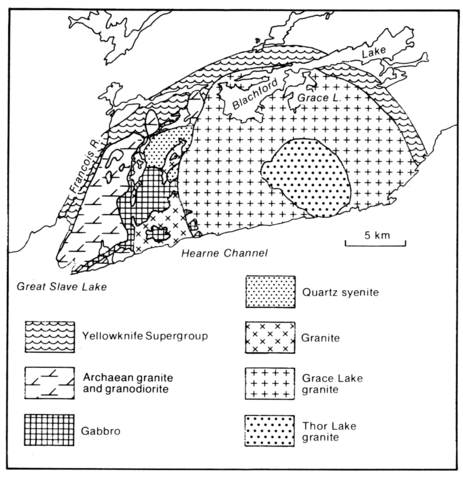stripes
The Blachford Lake complex intrudes Archaean granites and granodiorites and metasedimentary schists of the Yellowknife Supergroup, and is cut by diabase dykes and small plutons of diorite and granodiorite. The complex outcrops over some 235 km2, but another 140 km2 may be hidden beneath the Hearne Channel of the Great Slave Lake to the south. The successive phases of the complex changed with time from mildly alkaline gabbros, through increasingly alkaline diorite, syenite and granite, to peralkaline granite and syenite. The early olivine gabbro has a little hornblende and biotite. A later quartz syenite/granite contains pale green pyroxene and fayalite. The Grace Lake granite is by far the largest unit of the complex covering 155 km2, and it grades into the central Thor Lake syenite. The granite consists of perthite, an average of 25% quartz, and about 7% riebeckite, which increases slightly inwards. Fluorite is invariably present together with zircon, monazite and occasional green pyroxene with riebeckitic rims. Aegirine is sometimes found as overgrowths on riebeckite and is locally associated with astrophyllite. The contact with the Thor Lake syenite is gradational over a few metres. Five varieties of syenite can be distinguished, the outer one of which is a fayalite-pyroxene syenite. Both the syenite and granite are traversed by aegirine aplites and pegmatites in the north of the Thor syenite. An extensive area of aegirine aplite, rich in fluorite, is associated with U and Th mineralization. Pegmatites with aegirine, fluorite, astrophyllite, zircon and bastnaesite also occur in the Grace granite. The geochemistry of the complex including REE and a microprobe study of some of the rock-forming minerals has been investigated by Davidson (1982). Initial 87Sr/86Sr ratios are 0.700-0.703 for the earlier units, but the later peralkaline rocks give 0.711-0.714 (Wanless et al. 1979; Davidson, 1982, p. 77).
BADHAM, J.P.N. 1978. Magnetite-apatite-amphibole-uranium and silver-arsenide mineralizations in lower Proterozoic igneous rocks, East Arm, Great Slave Lake, Canada. Economic Geology, 73: 1474-91.
DAVIDSON, A. 1978. The Blackford Lake intrusive suite: an Aphebian alkaline plutonic complex in the Slave Province, Northwest Territories. Paper, Geological Survey of Canada, 78-1A: 119-27.
DAVIDSON, A. 1982. Petrochemistry of the Blachford Lake complex near Yellowknife, Northwest Territories. Paper, Geological Survey of Canada, 81-23: 71-9.
WANLESS, R.K., STEVENS, R.D., LACHANCE, G.R. and DELABIO, R.N. 1979. Age determinations and geological studies: K-Ar isotopic ages, Report 14. Paper, Geological Survey of Canada, 79-2: 34-8.

